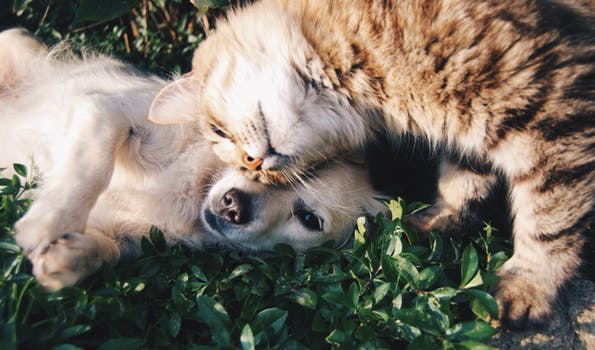Essential Oils and Your Pets: A Quick How-To
I love to share essential oils with my family, so it makes sense that I would share them with my dog as well! Before you begin using essential oils for pets, you need to know the answers to some important questions: Are essential oils safe for pets? Can you use essential oils on dogs, cats, and other pets the same way you use them on yourself? How much should you use? What is the best way to administer oils for topical use?
It is important to note that animals cannot tell us if something is working or not, so it is our duty to exercise due caution and approach using oils on animals safely and responsibly.
Basic Guidelines
Here are some general tips and suggestions you’ll want to keep in mind as you share essential oils with your furry friends.
Do not use essential oils on and around cats or dogs under 8 weeks old because they are developing at fast rates! Animals are generally more sensitive to essential oils than humans are. It’s best to heavily dilute essential oils and use them in moderation. Every animal is different, so carefully observe how your animal responds to essential oils. Use common sense and good judgment as you try different methods. Be especially careful to not get essential oils in an animal’s eyes. If diffusing, always allow cats access to areas where they can avoid the diffused oil. With all animals, avoid using high-phenol oils—such as Oregano, Wintergreen, Clove, Mountain Savory, and Thyme. This is especially important with cats! Use special caution with cats and essential oils. Avoid applying citrus oils topically, diffusing the scent around cats, and having your cat ingest them.
Essential Oil Acclimation
Your pets may need some time to adjust to the new scents and sensations of essential oils. Use these tips to introduce your pets to essential oils in an easy and comfortable way.
Wear essential oils throughout the day, so your pets will be exposed to the aroma as you hold them, play, or cuddle on the couch. Diffuse essential oils in spaces where your pets like to relax. Keep in mind that dogs tend to stay in a room with their owner even if something is bothering them. Closely watch for signs of irritation—such as whining, sniffing, nervousness, and excessive scratching—while diffusing around them. When diffusing essential oils around cats, be sure to only diffuse in areas that allow the cat to leave if it doesn’t want to be there. Apply an essential oil to your hands and let your pets smell them, so they can explore the scent on their own terms. If your pets are jittery or resistant to essential oils, try applying an oil to yourself and staying near the pets for several minutes, so they can get used to the aroma. V-6 Vegetable Oil ComplexDilution (found at Young Living) for Topical Application Your animal’s size affects the amount of oil you should use and how much you should dilute for topical application. My dog Jameson get’s stomach aches A LOT! I use Young Living’s V-6 Oil and a couple of drops of Peppermint on his belly and it works every time. He is soothed by it and feels better instantly! A neighbor of mine uses Lavender Oil in the same way to calm her dog when there is a thunderstorm. Sammy does well with Lavender and it has a calming affect on her almost immediately!
For cats, small dogs, and other smaller animals, use a carrier oil—such as V-6™ Vegetable Oil Complex—to dilute the essential oil before application. We suggest a 4:1 ratio of carrier oil to essential oil. If you’re using essential oils on medium-sized animals—like large dogs—dilute 3:1 carrier oil to essential oil.
If you apply oils to places on their body they can lick, they will likely consume some of the essential oil as they groom and play. Make sure you dilute heavily, so the amount your pet licks is minimal.
Young Living also offers a full line of animal-specific products, including essential oil blends made just for animals, cat treats, dental pet chews, and Animal Scents® Shampoo.
**Please note that these are general recommendations for use. If your veterinarian suggests other usage, defer to your veterinarian. If your pet is pregnant, nursing, or has a medical condition, consult a veterinarian prior to use.


